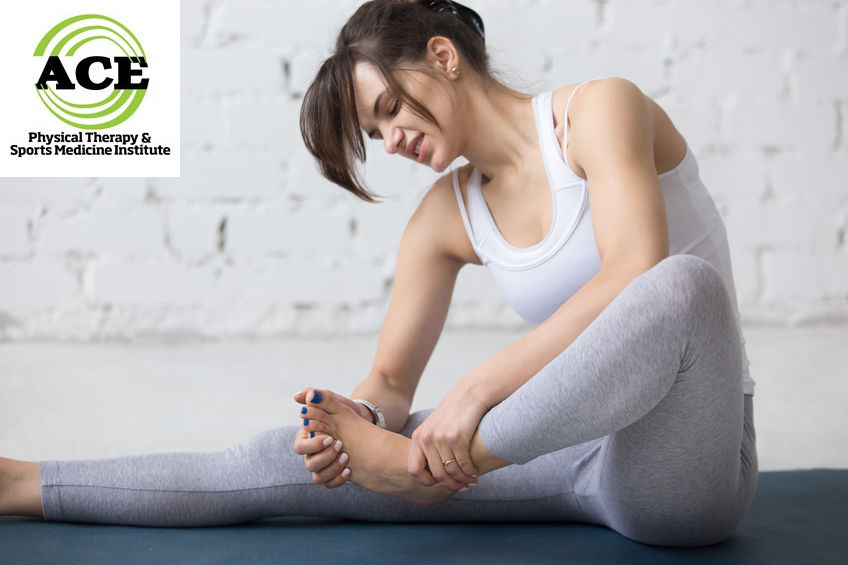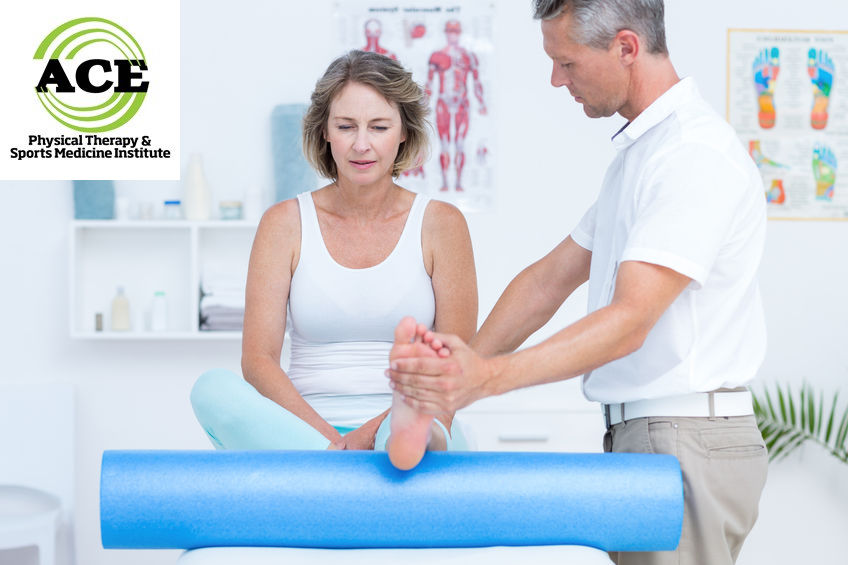WHY DO YOUR FEET OR ANKLES HURT SO MUCH?

Tid Bits of Info
- The foot has 26 bones.
- Women have 4x as many foot problems as men and high heels are one of the major causes.
- The average person walks more than 100,000 miles in their lifetime.
- Toenails thicken as we age.
- If you have sore or painful feet, seek the treatment of a Physical Therapist.
Pain in the feet or ankles can make it miserable to work or play. In fact, it may cause you to give up activities and even lead to an unhealthy sedentary lifestyle. Healthcare professionals treat foot and ankle pain every day. Treating the symptoms requires correcting the underlying problems that have caused the pain.
While there are many reasons for feet or ankle pain, almost all of them are directly related to weight bearing forces that take place in the feet and ankles with every step. Too much force on feet or ankles for too long a time can cause pain. By reducing body weight, maintaining strength in the lower extremity muscles, and wearing proper shoe type and size, patients can combat the onset of these symptoms.
The feet and ankles are complex and consist of numerous bones and joints that work in unison as someone places weight on their foot. The complex must be able to handle the body weight and the force of gravity to sustain impact, absorb the shock and then propel the weight to the next step or stride. The amount of force is dependent upon speed of gait, terrain, shoe composition and several other factors but in the end, the foot and ankle must be able to control the landing and propel the body weight without sustaining damage.
Overpronation: Overpronation is one of the most common causes of foot and ankle pain. The foot and ankle complex move through a particular range of motion based on the shape of an individual’s bones in the foot. The genetics of the individual determines the shape of the bones, therefore someone who “over-pronates” is genetically predisposed to this condition. The movement is completed when the individual moves from heel strike to midstance in the natural gait cycle. The medial aspect of the foot moves towards the floor and in the “over” pronator, the medial arch might touch the floor. Pronation is needed in the gait cycle to absorb shock during the mid-stance phase which helps to reduce the frequency of impact-related injuries, but it can place more stress and strain on some the soft tissues in the foot and ankle. The extra stress and strain can lead to tendinitis or worst case scenario a tendon rupture if it is allowed to continue during the gait cycle. Treatment for this condition begins with shoes that provide support to the medial arch. There are exercises that will help to control the entire leg because weakness in the hips can lead to an increase in stress and strain on these structures.
Posterior tibialis and Achilles tendinitis: The soft tissue of the foot and ankle complex consists of muscles, tendons, and ligaments. The ligaments provide static stability to the joints and the muscles provide dynamic stability. The muscles attach to the bones via a tendon. In most instances, the muscle does not get damaged, but the repetitive nature of walking and running places a tremendous amount of stress and strain on certain tendons. Two of the most common sites of tendon damage are the posterior tibialis and Achilles tendons.
Both of these tendons can be negatively affected by excessive pronation of the foot and ankle and/or repetitive high impact forces. The posterior tibialis tendon is responsible for helping to control the rise and fall of the medial side of the foot. The tendon helps to lower the arch to the ground after impact until the person transitions to midstance. It then “pulls” on the arch to raise if off of the ground as the gait cycle moves through the aspect of toe off. In the event that too much pronation exists, the arch is forced to the ground excessively and the posterior tibialis must “work” harder to control or move it. The extra workload on the tendon can lead to tendinitis symptoms. The Achilles tendon is responsible for “pulling” or “lifting” the heel off of the ground at the end of the gait cycle. If the foot and ankle transverse through too much motion, the Achilles tendon can be damaged. This tendon is under a great deal of stress and strain during jumping or running activities. Too much stress and strain can lead to tendinitis or rupture of this tendon.
Plantar fasciitis: The plantar fascia extends along the sole of the foot from the heel bone to each tendon that flexes or curls the toes. This thick band of non-elastic tissue helps to support the arch from the bottom. It is placed under a great deal of tension during weight bearing and can be damaged. The most common site of the damage is at the attachment to the heel bone. This condition is prominent in “over-pronators” and people who are involved in high impact activities. One of the most common symptoms of this condition is intense pain first thing in the morning upon taking the first step out of bed. It feels like a stone under the bottom of the heel bone.

When your feet hurt, your whole day is affected. It is truly a challenge to move from point A to B. You should seek the advice and treatment for foot pain from a Physical Therapist. These licensed professionals can help you with pain and symptom control and teach you different exercises that will stretch and strengthen the lower extremity muscles and joints. They will include core exercises to help stabilize the hips and legs.
Painful feet and ankles can occur in anyone and for a number of reasons. In most instances, an individual that performs high level or repetitive weight-bearing activities will be more susceptible foot and ankle pain. Wearing the proper shoes, keeping your core and lower extremities in good shape and avoiding excessive repetitive or high impact activities should help anyone avoid the curse of sore, painful feet.
























